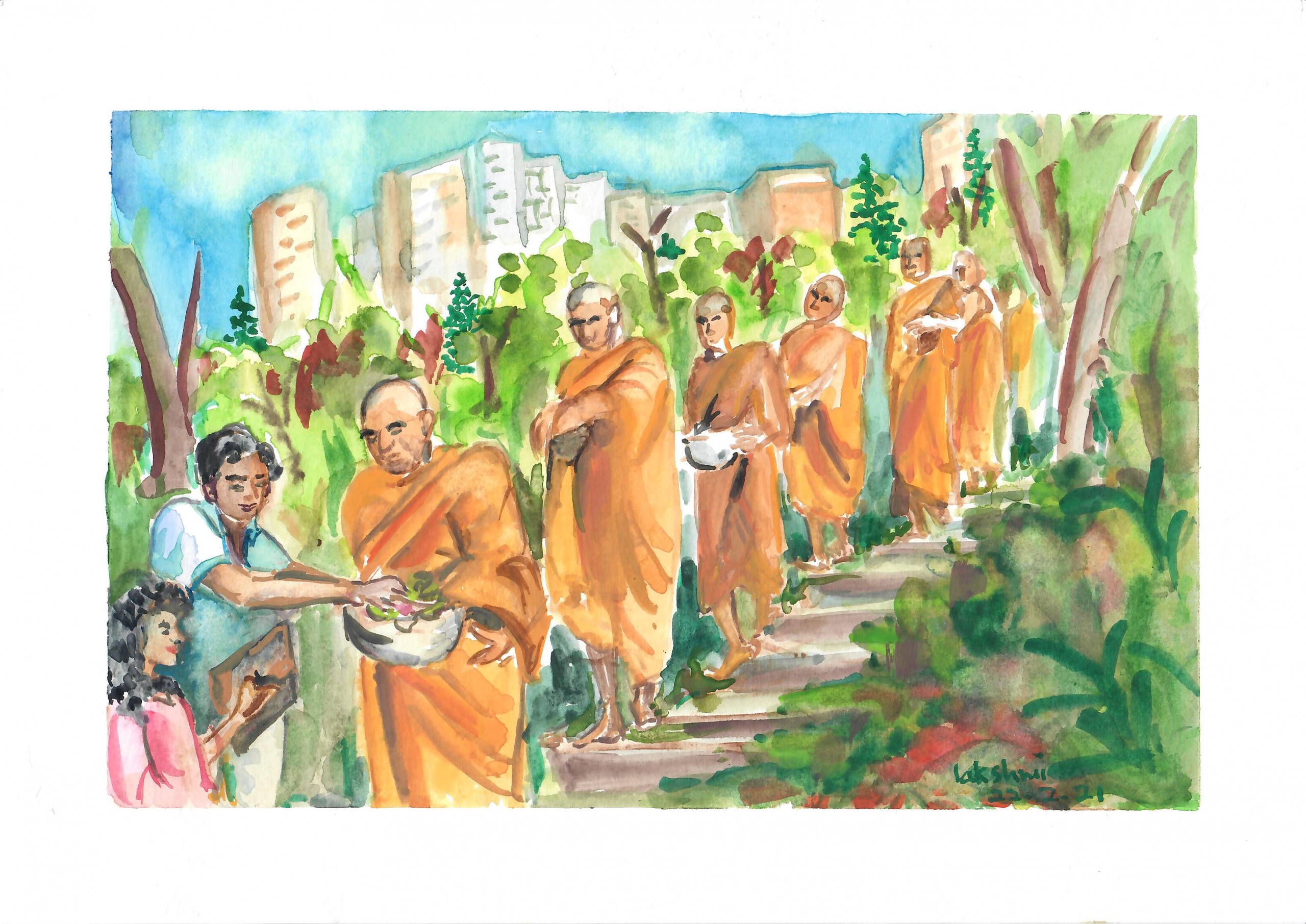What is Buddhism?
- Many people consider Buddhism to be a religion while others consider it to be a philosophy or a way of life based on the teachings of the Gautama Buddha who lived in India 2,600 years ago. The word comes from ‘budhi’, meaning “to awaken”. The Buddha is the awakened or enlightened one. Buddhism views life as permeated with suffering caused by desire. Enlightenment – obtained through right conduct, wisdom and meditation – releases one from desire, suffering and rebirth. There are around 300-500 million Buddhists in the world, with numbers increasing in the West.
What does a Buddhist believe in?
- There is no belief or blind faith in Buddhism as such. In its place is the concept of Saddha or confidence based on knowledge, self-discovery and reflection. The confidence that Buddhist followers have in the Buddha is similar to the confidence that a patient has in a competent physician. No more, no less. The Buddha, as teacher, instructs us, but we ourselves are directly responsible for our purification. Although a Buddhist seeks refuge in the Buddha, s/he does not make any self-surrender or sacrifice their freedom of thought. One can exercise one’s own free will and develop knowledge even to the extent of becoming a Buddha oneself.
What does a Buddhist do?
- A Buddhist walks the path to enlightenment through the Noble Eightfold Path: right understanding, right intention, right speech, right action, right livelihood, right effort, right mindfulness and right concentration. Buddhists are either lay followers (leading a normal family life) or ordained as celibate monks and nuns. There are varying intensities of the rules or “precepts” one can follow. Lay followers traditionally follow five rules (do not kill, steal, commit sexual misconduct, lie or consume intoxicating drinks or drugs). On special religious days, every full moon day of each month, lay devotees may add another three rules to follow the 8 precepts. Ordained clergy have hundreds of rules to follow, all with the aim of developing ethical conduct, mindfulness and wisdom.

Do Buddhists pray?
- Buddhists do not pray to a personal or creator God but recite stanzas and scriptures to remind themselves of various aspects of the Dhamma or Buddha’s teachings. These stanzas are recited in the ancient Indian languages of Pali or Sanskrit. Buddhists bring their hands together as if in prayer during recitals. Buddhists also meditate to improve mindfulness and develop the right concentration and insight. This can be done either seated with hands in their laps or by walking. In Buddhism, there is no asking for favours from a God or supernatural being. Buddhists strive to find peace and happiness in themselves.
How can Buddhism help me?
- Buddhism explains there is a purpose to life. It explains apparent injustice and inequality around the world, and it provides a code of practice or way of life that leads to true happiness. It can help deal with the stresses and challenges of modern life and create peace within ourselves, our families and in society at large. It can be practiced by anyone, anywhere.
Why is Buddhism becoming popular?
- Buddhism is becoming popular in western countries for a number of reasons. Firstly, it provides meaningful answers to many of the problems faced by modern, materialistic societies. It also includes a deep understanding of the human mind. Prominent psychologists around the world are now discovering the effectiveness of the natural therapies embraced by Buddhism.
Who was the Buddha?
- Siddhartha Gotama was born into a royal family in Lumbini (then north-east India, and now in Nepal) in 563 BC. At the age of 29, he realized that wealth and luxury did not guarantee happiness, so he explored the different religious teachings and philosophies of the day in an attempt to find the key to human happiness. After six years of study and meditation he finally found ‘the middle path’ – the Noble Eightfold path mentioned above – and was enlightened. After enlightenment, the Buddha spent the rest of his life teaching the principles of Buddhism — called the Dhamma, or Truth — until he passed away at the age of 80.
“There are two mistakes one can make along the road to truth – not going all the way, and not starting.” Buddha

Was the Buddha a God? Do Buddhists worship idols?
- The Buddha was not a God, nor did he claim to be. He was a man who taught a path to enlightenment from his own experience. He developed his mind and achieved very high mental states which enabled him to carry out acts which many find magical.
Buddhists sometimes pay respect to images of the Buddha, not in worship, nor to ask for favours. A statue of the Buddha with hands resting gently in its lap and a compassionate smile reminds us to strive to develop peace and love within ourselves. Bowing to the statue is an expression of gratitude for the Buddha’s teachings and is part of the way many Asian cultures pay respect to elders and teachers. For many, statues of the Buddha help to concentrate the mind before meditation.
Are there different types of Buddhism?
- Buddhism was never spread through invasion or violence. It took several hundred years to go from India to Iran and Tajikistan in the west and to China, Japan and Korea in the east. As it spread it took on the cultural aspects of each country: as a result, there are many different schools of Buddhism. The two main schools today are: Theravada and Mahayana.
Theravada – the teaching of the elders- is practiced in the Buddhist countries of southern Asia – Sri Lanka, Cambodia, Laos, Burma and Thailand. It is the most orthodox or unchanged form of Buddhism. The earliest available teachings of the Buddha are found in Pali literature and belong to the school of the Theravada. This school acknowledges the human characteristics of the Buddha, is characterized by a psychological understanding of human nature, and emphasizes a meditative approach to the transformation of consciousness.
Mahayana is more of an umbrella for a great variety of schools, from the Tantra school well represented in Tibet and Nepal to the Pure Land sect, which is more common in China, Korea and Japan. Ch’an and Zen Buddhism, found in China and Japan, are meditation schools. According to these schools, to look inward and not outwards is the only way to achieve enlightenment.
The Buddha’s teaching or Dhamma, however, does not change essentially regardless of the school.
Is Buddhism scientific?
- Science is knowledge which can be made into a system, which depends upon seeing and testing facts and stating general natural laws. The core of Buddhism fits into this definition, because the Four Noble Truths can be tested and proven by anyone. In fact, the Buddha himself asked his followers to test the teaching rather than accept his word as true. Buddhism depends more on understanding than faith.
“The religion of the future will be a cosmic religion… a religion which based on experience, which refuses dogmatic. If there’s any religion that would cope with the scientific needs it will be Buddhism….”
Albert Einstein 1879-1955
Nobel Prize for Physics in 1921
What is Karma?
- Karma is the natural law that every cause has an effect. This means that our actions have results. Good begets good. Bad begets bad. This simple law explains that all individuals are responsible for their past and present actions. To test the karmic effect of our actions, we need to answer three questions: what is the intention behind the action, what are the effects of the action on oneself, and what are its effects on others. Some karma acts in this life, either immediately or with some delay. Some karma is effective in the next life, and some karma is delayed for many lifetimes, while other karma can be offset by good or wholesome deeds. Buddhism emphasizes how we are masters of our destiny, and how we can change our existing karma or influence our future karma.
Do Buddhists believe in re-incarnation?
- No. To be re-incarnated, one needs a soul. Buddhism does not subscribe to the notion of a soul. Instead, Buddhism acknowledges rebirth and describes how the stream of consciousness upon death becomes the contributing factor to a new aggregation or life. Other words used to describe this are “metempsychosis” and “transmigration”. The new life is neither identical nor entirely different from the deceased. The two form a continuum or stream. The new life can be in human or animal form, or in several supernatural realms. The objective of Buddhism is to escape from this continuous, never-ending process of death and re-birth with all its associated dissatisfaction, suffering and sorrow, to a state of not being born called Nirvana. Nirvana means “blowing out” – the blowing out of the fires of greed, hatred and delusion.
